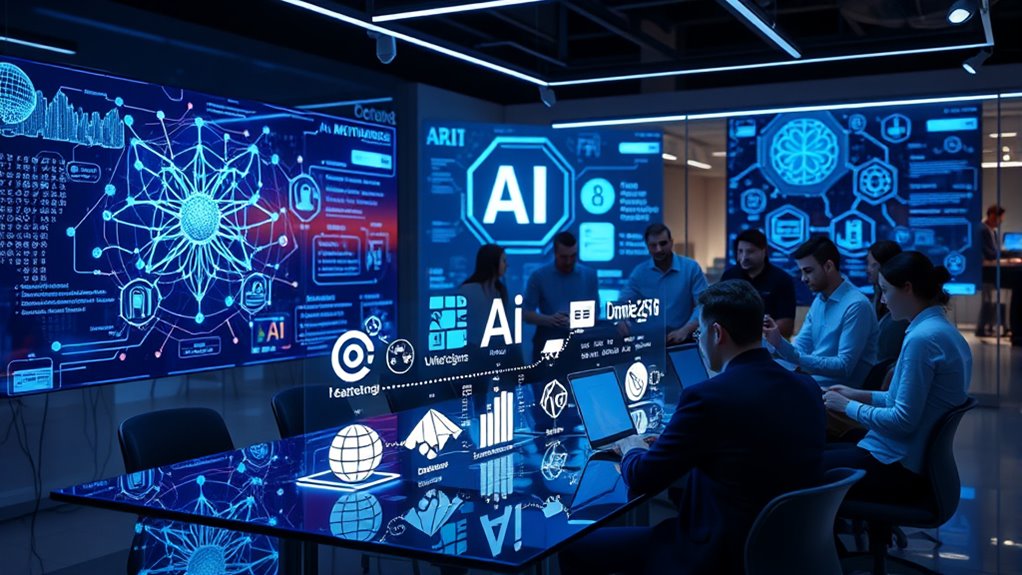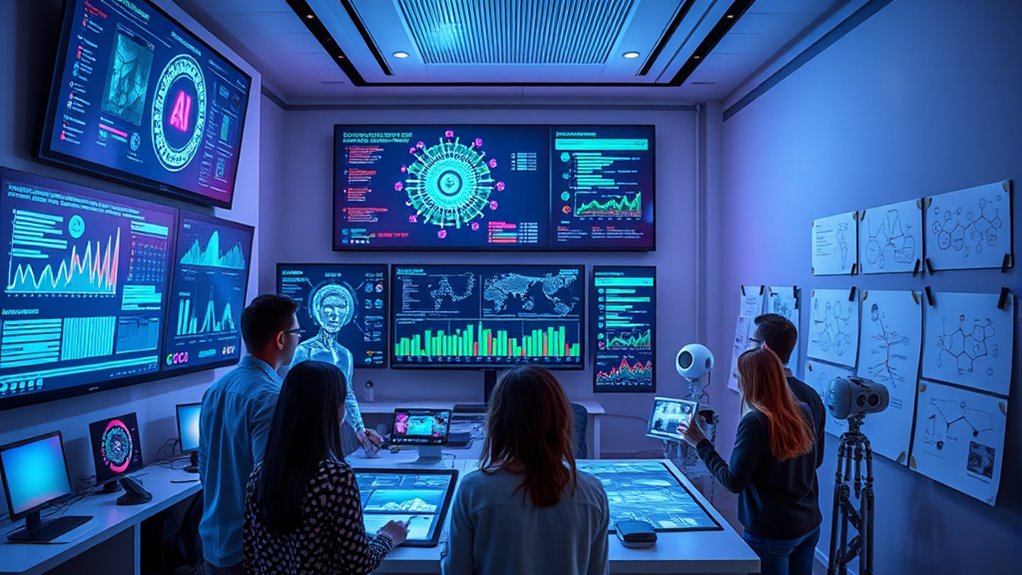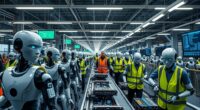Understanding AI involves exploring its core technologies like machine learning, deep learning, natural language processing, and computer vision. Leading companies like Google, OpenAI, and Microsoft are advancing AI applications across industries, from healthcare to autonomous vehicles. These innovations are driven by powerful hardware such as GPUs and TPUs, enabling faster and more accurate models. As AI shapes the future, staying informed about its capabilities and ethical considerations will help you see what’s next—keep exploring to learn more.
Key Takeaways
- AI encompasses technologies like machine learning, deep learning, and natural language processing that drive modern applications.
- Major tech companies such as Google, OpenAI, and Microsoft develop foundational models and AI solutions shaping the future.
- Hardware advances, including GPUs and TPUs, accelerate AI processing, enabling more complex and real-time applications.
- AI’s future involves evolving toward stronger, human-like intelligence, with ongoing research into explainability and ethical use.
- AI impacts diverse sectors including healthcare, autonomous vehicles, finance, and customer service, transforming industries worldwide.

Have you ever wondered how machines can perform tasks that seem to require human intelligence? It all comes down to Artificial Intelligence, or AI. AI enables machines to recognize images, understand language, and make decisions—tasks you’d typically associate with people. These systems analyze enormous amounts of data, identify patterns, and learn from experience, getting better over time. You should know that AI falls into two main categories: Narrow AI, which is designed for specific tasks, and General AI, which would mimic human-like cognition across multiple domains. Key subsets include machine learning, deep learning, natural language processing, and computer vision, each playing a vital role in AI’s capabilities. Combining knowledge from computer science, data analytics, linguistics, and neuroscience, AI stands at the intersection of many disciplines.
So, how does AI actually work? It relies on algorithms—mathematical formulas that process data to enable learning and decision-making. Large datasets fuel this process, helping AI systems recognize patterns and improve their predictions. During model training, data is fed into the system, allowing it to learn which patterns are most relevant for specific tasks. AI architecture generally includes three layers: the data layer, where data gets prepared; the model layer, which employs machine learning or deep learning; and the application layer, where AI interacts with users. Foundation models, like large language models, are trained on diverse data and can be fine-tuned for particular applications, making them adaptable tools in AI development. Advances in hardware, such as GPUs and TPUs, have significantly accelerated AI processing capabilities. You should also understand that machine learning is a core part of AI. It involves creating algorithms that learn from data without needing explicit instructions for every task. This ability to improve over time makes ML useful in applications like predictive texting, financial trading, and self-driving cars. Deep learning, a subset of ML, uses neural networks with multiple layers to model complex patterns. These networks mimic brain structures, transforming data through interconnected layers. Deep learning has led to breakthroughs in medical imaging, autonomous vehicles, and speech recognition—areas where AI’s accuracy continues to grow.
Additionally, ongoing research in explainability and transparency aims to make AI systems more understandable and trustworthy for users and developers alike. In essence, AI today is mostly weak or narrow, meaning it specializes in specific tasks without true understanding. Virtual assistants like Siri or Alexa are examples. Strong AI, which would possess human-like consciousness and reasoning, remains theoretical. As AI advances, it’s shaping our future in ways we’re just beginning to understand.
Frequently Asked Questions
How Does AI Impact Job Security Across Industries?
AI impacts your job security by causing both displacement and new opportunities across industries. You might face layoffs in manufacturing and customer service, but AI also creates roles in healthcare, education, and tech. To stay secure, you’ll need to reskill and adapt, as AI-driven change is ongoing. While some job risks exist, AI’s overall effect is temporary, and new jobs will emerge that can offer stability if you stay proactive.
What Are the Ethical Concerns Surrounding AI Development?
You should be aware that ethical concerns in AI development include bias and fairness issues, privacy violations, and transparency challenges. You might unintentionally perpetuate discrimination if biases aren’t addressed, and sensitive data could be misused or exposed. Additionally, lack of explainability and accountability makes it hard to trust AI decisions. To mitigate these risks, you need ongoing scrutiny, inclusive stakeholder input, and strong governance to guarantee AI benefits everyone ethically and fairly.
How Can AI Bias Be Effectively Mitigated?
You can effectively mitigate AI bias by transforming and balancing your training data, ensuring it represents diverse populations. Use fairness-aware algorithms during training, and continuously audit your models for hidden biases. Incorporate multidisciplinary teams for better oversight and apply post-processing adjustments to fairness outcomes. Regularly monitor and update your systems, documenting every step transparently, so your AI remains fair, trustworthy, and aligned with ethical standards.
What Are the Costs Associated With Implementing AI Solutions?
You should expect significant costs when implementing AI solutions. Initial investments range from $5,000 for small businesses to several million for large enterprises, covering software licenses, hardware, and integration. Ongoing expenses include rising computing costs, data storage, and maintenance, which can add up quickly. Industry-specific projects typically cost between $80,000 and $500,000, with timelines spanning 3 to 8 months. Overall, AI adoption requires substantial financial planning and resource allocation.
How Will AI Influence Global Economic Power Dynamics?
AI will shift global economic power by favoring advanced economies that lead in innovation and investment. You’ll see wealth and influence concentrate in regions with strong AI infrastructure, widening inequalities. Countries that embrace AI early can create new markets, boost productivity, and strengthen their positions. However, those lagging behind risk falling further behind economically, making AI a key factor in future geopolitical and economic competitions.
Conclusion
As you explore AI’s landscape, remember it’s transforming industries faster than ever. Did you know that by 2025, over 97 million people will be working alongside AI-powered tools? This shift highlights how essential it is to stay informed and adaptable. Embrace these technologies, and you’ll be better prepared for the future. AI isn’t just a trend—it’s shaping your world, so get ready to be part of this exciting evolution.










